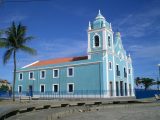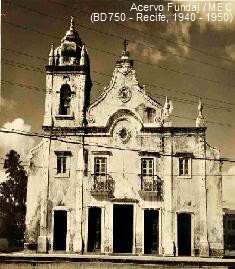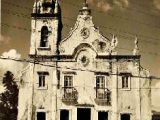Este post também está disponível em:
Português
English

The Nossa Senhora da Boa Viagem Church in Pracinha de Boa Viagem in Recife, which was built on the sand of the beach, has its first records dating from the 17th century.
Around 1862, the Church of Our Lady of Boa Viagem underwent a major renovation, which gave it its current appearance. It underwent internal and external changes, with only the altar of the sacristy being preserved.
“From the opening of the tram lines and Boa Viagem Avenue, the neighbourhood grew and modernised and the church was one of the only historic buildings in the South Zone that resisted modern constructions.”
History of Nossa Senhora da Boa Viagem Church
Until the mid-17th century, the Igreja Nossa Senhora da Boa Viagem was located in the former territory of Barreta, corresponding to the entire coastal area, which extended from the front of Pina to the village of Candeias.
No precise source is known that can guarantee the date of the church’s opening. It is known, however, that the church was ready in 1743.
Before 1848, the chapel belonged to the parish of Nossa Senhora da Paz, in Afogados, and it was only on 8 September of that year that it was raised to the level of an independent parish.
Video “Nossa Senhora da Boa Viagem Church in Recife”

Igreja Nossa Senhora da Boa Viagem em Recife
The oldest document about the Nossa Senhora da Boa Viagem Church is a deed dated 6 June 1707.
In it, Balthazar da Costa Passos and his wife, Ana de Araújo Costa, donated to Father Leandro Camelo a place where there was an “oratory or presepe to Jesus and Mary, together with the soil that was nearby, which was a site of land in Barreta with a hundred arms in front and a league in back, from the beach to the River Jordan”.
Also in their wills, the donors, being very religious, added to the chapel’s assets another site next door, ‘with 500 hectares of land, with thirty-odd coconut trees, where there is a mud house for sale in which Manuel Setúbal used to live’.
Another piece of information from historical documents emphasises that Father Leandro Camelo, known at the time as a ‘man of great virtues’, used everything he had to make a living. using everything he had, had an image made of the Good Journey, in honour of the Blessed Virgin Mary, and placed it in a magnificent church that he erected two leagues from Recife, on the shores of the sea, “placing his hopes in this Lady, whose care is to lead us always to the desired port of salvation”.

According to scholars on the subject, the Igreja Nossa Senhora da Boa Viagem, in the period of colonial Brazil, although modest, represented one of the temples with the highest patrimonial income in Recife.
It was owned by five large estates, four small ones and 20 single-storey houses in the town, as well as a small coconut grove on the beach donated by Father Luís Marques Teixeira with the sole commitment that “the amount necessary to keep the lamp in the church’s chancel lit day and night” would be taken from his income.
The major renovations to the Igreja Nossa Senhora da Boa Viagem began in 1862.
In place of the previous building, a new one was erected with a more solemn structure. Before that, there was a small church with simple lines and a porch in front, which looked more like one of those modest temples in rural areas.
During the renovation, the churchmen preserved some altars, including the one in the sacristy of the Igreja Nossa Senhora da Boa Viagem. Dating from 1745, this altar was carved by the master João Pereira and gilded by the artist Francisco Teixeira Ribeiro in 1772.
Undeniably, it was the Chapel of Boa Viagem that gave its name to its beautiful beach. It is worth mentioning among the administrators the donors of the land themselves; the brother of Bhaltazar Passos, Antônio da Costa Passos, and wife Catarina de Araujo Sampaio; the priests Luiz Marques Teixeira and Inácio Ribeiro Noia.
At the beginning of the 20th century, access to Boa Viagem was still quite difficult. In 1908, for example, according to scholars on the subject, there were only about 60 houses of regular construction and a chapel.
The village was only alive from September to March, when the seaside resort was popular.
At a distance of 11 km from the centre of Recife, Boa Viagem only gained momentum after the Avenida Beira-Mar was built. This enables the population to use the electric tram to go to the beach.
Before that, however, there was only one donkey-drawn tramway, inaugurated in 1899.
In parallel with the work on the church over the last three hundred years, the administrators have tried to collaborate as much as possible in the preaching of the Gospel and in the liturgical celebrations, creating an aura of attraction for the people who passed through or lived there: boat people, fishermen, travellers, among others.
Above all, they were warned that there were serious problems of the soul, whose vigil could not be abandoned.
On 8 September 1948, by decree of Archbishop Miguel de Lima Valverde, the church was founded. Miguel de Lima Valverde, the Parish of Nossa Senhora da Boa Viagem was created, with the elevation of its church to the category of matrix, being its first parish priest Monsignor Romeu Vasconcelos de Sá Barreto, who remained here from 1 January 1949 to 06 August 1967, when he died.
Tourism and Travel Guide of Recife, Pernambuco and Northeast Brazil
Religious Tourism and Sacred Recife
Tourism and Travel Guide



















